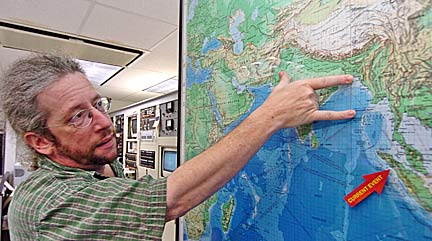TSUNAMI WARNING CENTER

A delegation of Sri Lankan officials visited the Pacific Tsunami Warning Center yesterday to see what they need to do to set up a similar warning system in the Indian Ocean. Before the tour, Barry Hirshorn, a geophysicist at the center, pointed to an area he is concerned about for possible future earthquakes and tsunami damage.
Isles are model
for Sri Lanka
Lawmakers learn about tsunami
defense systems and response
Four members of Sri Lanka's Parliament are in Honolulu through tomorrow to learn how to better prepare to deal with natural disasters like the Dec. 26 tsunami, which killed an estimated 31,000 people across Sri Lanka and left about 1 million homeless.
The Parliament members are part of a select committee that will make recommendations to the government on setting up a tsunami warning system in Sri Lanka and improving the country's ability to prevent loss of life and improve response after a disaster.
They visited the Pacific Tsunami Warning Center yesterday and questioned director Charles "Chip" McCreery on whether a warning could have been issued for Sri Lanka on Dec. 26.
Mahinda Samarasinghe, the delegation leader, said there was a misunderstanding of the role of the warning center.
"We got it cleared up," Samarasinghe said.
McCreery said he explained that the center cannot determine just from seismic data that a dangerous tsunami has been generated.

Charles McCreery, left, director of the Pacific Tsunami Warning Center, and Parliament members Mahinda Samarasinghe, John Amaratunga and Wijedasa Rajapakshe looked at earthquake readings from a quake that happened yesterday.
The key, he said, is sea level data from buoys, which are being set up as part of a new Indian Ocean warning network.
Samarasinghe said he learned there was no protocol and that the tsunami warning center had no phone numbers of anyone to call to warn about the tsunami.
Now, he said, there is a system in place and that the center does know whom to warn if there is another large earthquake that could generate a tsunami.
Before Dec. 26 no one in Sri Lanka knew what a tsunami was, Samarasinghe said.
"There are huge gaps which we have to fill very fast," he said.
For example, he said there are no seismologists in Sri Lanka.
One recommendation, Samarasinghe said, might be to send scientists or graduate students to the United States for training in seismology.
Today, the group will hear from the East-West Center about the center's tsunami relief efforts and visit the state civil defense headquarters.
Samarasinghe said there is no civilian civil defense system in Sri Lanka, and he is learning how cities and states coordinate their efforts.
The visit by the members of Parliament was organized by the U.S. State Department as part of its International Visitor Leadership Program.
www.prh.noaa.gov/ptwc/
Parliament of Sri Lanka
www.priu.gov.lk/Parliament/Indexpa.html
[News] [Business] [Features] [Sports] [Editorial] [Do It Electric!]
[Classified Ads] [Search] [Subscribe] [Info] [Letter to Editor]
[Feedback]
